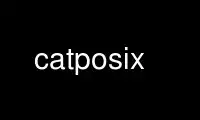
This is the command catposix that can be run in the OnWorks free hosting provider using one of our multiple free online workstations such as Ubuntu Online, Fedora Online, Windows online emulator or MAC OS online emulator
PROGRAM:
NAME
cat — concatenate and print files
SYNOPSIS
cat [−u] [file...]
DESCRIPTION
The cat utility shall read files in sequence and shall write their contents to the
standard output in the same sequence.
OPTIONS
The cat utility shall conform to the Base Definitions volume of POSIX.1‐2008, Section
12.2, Utility Syntax Guidelines.
The following option shall be supported:
−u Write bytes from the input file to the standard output without delay as each is
read.
OPERANDS
The following operand shall be supported:
file A pathname of an input file. If no file operands are specified, the standard
input shall be used. If a file is '−', the cat utility shall read from the
standard input at that point in the sequence. The cat utility shall not close
and reopen standard input when it is referenced in this way, but shall accept
multiple occurrences of '−' as a file operand.
STDIN
The standard input shall be used only if no file operands are specified, or if a file
operand is '−'. See the INPUT FILES section.
INPUT FILES
The input files can be any file type.
ENVIRONMENT VARIABLES
The following environment variables shall affect the execution of cat:
LANG Provide a default value for the internationalization variables that are unset or
null. (See the Base Definitions volume of POSIX.1‐2008, Section 8.2,
Internationalization Variables for the precedence of internationalization
variables used to determine the values of locale categories.)
LC_ALL If set to a non-empty string value, override the values of all the other
internationalization variables.
LC_CTYPE Determine the locale for the interpretation of sequences of bytes of text data
as characters (for example, single-byte as opposed to multi-byte characters in
arguments).
LC_MESSAGES
Determine the locale that should be used to affect the format and contents of
diagnostic messages written to standard error.
NLSPATH Determine the location of message catalogs for the processing of LC_MESSAGES.
ASYNCHRONOUS EVENTS
Default.
STDOUT
The standard output shall contain the sequence of bytes read from the input files. Nothing
else shall be written to the standard output.
STDERR
The standard error shall be used only for diagnostic messages.
OUTPUT FILES
None.
EXTENDED DESCRIPTION
None.
EXIT STATUS
The following exit values shall be returned:
0 All input files were output successfully.
>0 An error occurred.
CONSEQUENCES OF ERRORS
Default.
The following sections are informative.
APPLICATION USAGE
The −u option has value in prototyping non-blocking reads from FIFOs. The intent is to
support the following sequence:
mkfifo foo
cat −u foo > /dev/tty13 &
cat −u > foo
It is unspecified whether standard output is or is not buffered in the default case. This
is sometimes of interest when standard output is associated with a terminal, since
buffering may delay the output. The presence of the −u option guarantees that unbuffered
I/O is available. It is implementation-defined whether the cat utility buffers output if
the −u option is not specified. Traditionally, the −u option is implemented using the
equivalent of the setvbuf() function defined in the System Interfaces volume of
POSIX.1‐2008.
EXAMPLES
The following command:
cat myfile
writes the contents of the file myfile to standard output.
The following command:
cat doc1 doc2 > doc.all
concatenates the files doc1 and doc2 and writes the result to doc.all.
Because of the shell language mechanism used to perform output redirection, a command such
as this:
cat doc doc.end > doc
causes the original data in doc to be lost.
The command:
cat start − middle − end > file
when standard input is a terminal, gets two arbitrary pieces of input from the terminal
with a single invocation of cat. Note, however, that if standard input is a regular file,
this would be equivalent to the command:
cat start − middle /dev/null end > file
because the entire contents of the file would be consumed by cat the first time '−' was
used as a file operand and an end-of-file condition would be detected immediately when '−'
was referenced the second time.
RATIONALE
Historical versions of the cat utility include the −e, −t, and −v, options which permit
the ends of lines, <tab> characters, and invisible characters, respectively, to be
rendered visible in the output. The standard developers omitted these options because they
provide too fine a degree of control over what is made visible, and similar output can be
obtained using a command such as:
sed −n l pathname
The latter also has the advantage that its output is unambiguous, whereas the output of
historical cat −etv is not.
The −s option was omitted because it corresponds to different functions in BSD and System
V-based systems. The BSD −s option to squeeze blank lines can be accomplished by the shell
script shown in the following example:
sed −n '
# Write non-empty lines.
/./ {
p
d
}
# Write a single empty line, then look for more empty lines.
/^$/ p
# Get next line, discard the held <newline> (empty line),
# and look for more empty lines.
:Empty
/^$/ {
N
s/.//
b Empty
}
# Write the non-empty line before going back to search
# for the first in a set of empty lines.
p
'
The System V −s option to silence error messages can be accomplished by redirecting the
standard error. Note that the BSD documentation for cat uses the term ``blank line'' to
mean the same as the POSIX ``empty line'': a line consisting only of a <newline>.
The BSD −n option was omitted because similar functionality can be obtained from the −n
option of the pr utility.
FUTURE DIRECTIONS
None.
Use catposix online using onworks.net services
